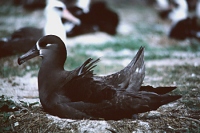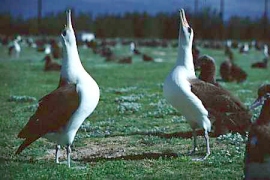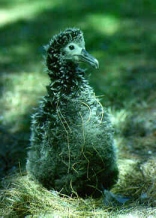HOME
ANIMALS
BIRDS
Albatross
 The
3.4 m (11 ft) wingspan of the wandering albatross, one of the
largest birds, is an adaptation allowing long distance flight over
vast expanses of open ocean. Generally restricted in their
distribution to between 45 and 70 degrees south latitude, albatrosses
feed on crustaceans, squid, and fish during the daylight and evening
hours. The wandering albatross lives for up to 30 years and may not
breed until the age of 15, when a single egg is laid and incubated
for 65 to 79 days.
The
3.4 m (11 ft) wingspan of the wandering albatross, one of the
largest birds, is an adaptation allowing long distance flight over
vast expanses of open ocean. Generally restricted in their
distribution to between 45 and 70 degrees south latitude, albatrosses
feed on crustaceans, squid, and fish during the daylight and evening
hours. The wandering albatross lives for up to 30 years and may not
breed until the age of 15, when a single egg is laid and incubated
for 65 to 79 days.
Albatross is
the common name applied to 13 species of large seabirds. Albatross
bills are characterized by a markedly hooked upper mandible with
tubular nostrils protruding from the base. The feet are strongly
webbed and lack a hind claw; the wings are long and narrow. Thirteen
species of albatross can be found mainly throughout seas of the
southern hemisphere, from the Antarctic region north to the Tropics;
a few species inhabit the North Pacific Ocean.
 Albatrosses
are nomadic birds that spend months wandering great distances over
the oceans. They sleep while floating on the ocean surface, drink
seawater, and feed on cuttlefish, other small marine animals, and
refuse from ships. They return to land only to breed, at which time
they perform a stylized courting ritual of elaborate bowing and
posturing. Albatrosses nest on barren islands, close to shore;
usually the nest is a depression in the ground containing a single
egg. When hatched, the nestling is covered with brownish down, and it
grows to adulthood relatively slowly.
Albatrosses
are nomadic birds that spend months wandering great distances over
the oceans. They sleep while floating on the ocean surface, drink
seawater, and feed on cuttlefish, other small marine animals, and
refuse from ships. They return to land only to breed, at which time
they perform a stylized courting ritual of elaborate bowing and
posturing. Albatrosses nest on barren islands, close to shore;
usually the nest is a depression in the ground containing a single
egg. When hatched, the nestling is covered with brownish down, and it
grows to adulthood relatively slowly.
 Albatrosses
are relatively fearless around humans, who have nicknamed the birds
“gooneys.” Nesting sites near military airstrips on small
islands have sometimes created problems because of the birds'
interference with takeoffs and landings. Albatrosses also often
follow a ship for days, diving steeply into the water to recover
refuse from the wake of the ship. The birds are easily caught with
baited hook and line; captured birds usually are released, however,
because of a superstition commonly held by sailors that killing an
albatross brings bad luck. The superstition forms the theme of
“The Rime of the Ancient Mariner” by the English poet
Samuel Taylor Coleridge.
Albatrosses
are relatively fearless around humans, who have nicknamed the birds
“gooneys.” Nesting sites near military airstrips on small
islands have sometimes created problems because of the birds'
interference with takeoffs and landings. Albatrosses also often
follow a ship for days, diving steeply into the water to recover
refuse from the wake of the ship. The birds are easily caught with
baited hook and line; captured birds usually are released, however,
because of a superstition commonly held by sailors that killing an
albatross brings bad luck. The superstition forms the theme of
“The Rime of the Ancient Mariner” by the English poet
Samuel Taylor Coleridge.
 Well-known
species include the wandering albatross, a huge bird with a 3.4 m
(11 ft) wingspread. The plumage of adults is white with black wing
tips; young birds are chocolate brown and become whiter as they grow
older. The Laysan albatross is a smaller, brown-winged species with a
sooty-black spot near the eyes and a gray bill. Another smaller
species is the black-footed albatross.
Well-known
species include the wandering albatross, a huge bird with a 3.4 m
(11 ft) wingspread. The plumage of adults is white with black wing
tips; young birds are chocolate brown and become whiter as they grow
older. The Laysan albatross is a smaller, brown-winged species with a
sooty-black spot near the eyes and a gray bill. Another smaller
species is the black-footed albatross.
The ages at
which birds begin to breed varies from less than a year in many
songbirds and some quail to ten years or more in some albatross. The
life spans of birds in the wild are poorly known. Many small
songbirds live only three to five years, whereas some albatross are
known to have survived more than 60 years in the wild.
Scientific
classification: Albatrosses make up the family Diomedeidae in the
order Procellariiformes. The wandering albatross is classified as
Diomedea exulans, the Laysan albatross as Diomedea immutabilis, and
the black-footed albatross as Diomedea nigripes.
Microsoft ®
Encarta ® Encyclopedia 2002. © 1993-2001 Microsoft
Corporation. All rights reserved.
http://www.wfu.edu/albatross/index.htm
 The
3.4 m (11 ft) wingspan of the wandering albatross, one of the
largest birds, is an adaptation allowing long distance flight over
vast expanses of open ocean. Generally restricted in their
distribution to between 45 and 70 degrees south latitude, albatrosses
feed on crustaceans, squid, and fish during the daylight and evening
hours. The wandering albatross lives for up to 30 years and may not
breed until the age of 15, when a single egg is laid and incubated
for 65 to 79 days.
The
3.4 m (11 ft) wingspan of the wandering albatross, one of the
largest birds, is an adaptation allowing long distance flight over
vast expanses of open ocean. Generally restricted in their
distribution to between 45 and 70 degrees south latitude, albatrosses
feed on crustaceans, squid, and fish during the daylight and evening
hours. The wandering albatross lives for up to 30 years and may not
breed until the age of 15, when a single egg is laid and incubated
for 65 to 79 days. Albatrosses
are nomadic birds that spend months wandering great distances over
the oceans. They sleep while floating on the ocean surface, drink
seawater, and feed on cuttlefish, other small marine animals, and
refuse from ships. They return to land only to breed, at which time
they perform a stylized courting ritual of elaborate bowing and
posturing. Albatrosses nest on barren islands, close to shore;
usually the nest is a depression in the ground containing a single
egg. When hatched, the nestling is covered with brownish down, and it
grows to adulthood relatively slowly.
Albatrosses
are nomadic birds that spend months wandering great distances over
the oceans. They sleep while floating on the ocean surface, drink
seawater, and feed on cuttlefish, other small marine animals, and
refuse from ships. They return to land only to breed, at which time
they perform a stylized courting ritual of elaborate bowing and
posturing. Albatrosses nest on barren islands, close to shore;
usually the nest is a depression in the ground containing a single
egg. When hatched, the nestling is covered with brownish down, and it
grows to adulthood relatively slowly. Albatrosses
are relatively fearless around humans, who have nicknamed the birds
“gooneys.” Nesting sites near military airstrips on small
islands have sometimes created problems because of the birds'
interference with takeoffs and landings. Albatrosses also often
follow a ship for days, diving steeply into the water to recover
refuse from the wake of the ship. The birds are easily caught with
baited hook and line; captured birds usually are released, however,
because of a superstition commonly held by sailors that killing an
albatross brings bad luck. The superstition forms the theme of
“The Rime of the Ancient Mariner” by the English poet
Samuel Taylor Coleridge.
Albatrosses
are relatively fearless around humans, who have nicknamed the birds
“gooneys.” Nesting sites near military airstrips on small
islands have sometimes created problems because of the birds'
interference with takeoffs and landings. Albatrosses also often
follow a ship for days, diving steeply into the water to recover
refuse from the wake of the ship. The birds are easily caught with
baited hook and line; captured birds usually are released, however,
because of a superstition commonly held by sailors that killing an
albatross brings bad luck. The superstition forms the theme of
“The Rime of the Ancient Mariner” by the English poet
Samuel Taylor Coleridge. Well-known
species include the wandering albatross, a huge bird with a 3.4 m
(11 ft) wingspread. The plumage of adults is white with black wing
tips; young birds are chocolate brown and become whiter as they grow
older. The Laysan albatross is a smaller, brown-winged species with a
sooty-black spot near the eyes and a gray bill. Another smaller
species is the black-footed albatross.
Well-known
species include the wandering albatross, a huge bird with a 3.4 m
(11 ft) wingspread. The plumage of adults is white with black wing
tips; young birds are chocolate brown and become whiter as they grow
older. The Laysan albatross is a smaller, brown-winged species with a
sooty-black spot near the eyes and a gray bill. Another smaller
species is the black-footed albatross.